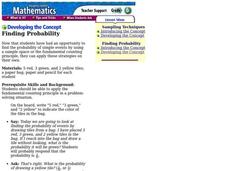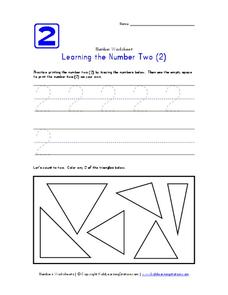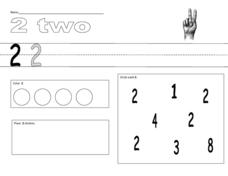Curated OER
Finding Probability
Students demonstrate how to find the probability of events. In this probability instructional activity, students use colored tiles in a paper bag and randomly select one at a time to record the probability.
EngageNY
Mixture Problems
What percent of the mixture is juice? Pairs use their knowledge of proportions to determine what percent a mixture is juice given the percent of juice in the components. Pupils use the procedure learned with the juice mixture problem to...
Curated OER
Pencil It In
In this recognizing patterns worksheet, students identify problems with patterns and draw the number of pencils that most likely come next. Students solve four problems.
Armory Center for the Arts
Place Value Collage
How can art represent math? Use a lesson on place value collages to illustrate the different meanings that numbers have in their designated places. Kids observe photographs and paintings that show place value, then work on their own.
EngageNY
Sequencing Translations
Investigate the results of multiple translations on an image. Scholars use vectors to perform a sequence of translations in the seventh lesson of 18. They examine the results and determine the importance of using a sequence rather than a...
Virginia Department of Education
Probability
Classes explore different scenarios using manipulatives to learn about the difference between independent and dependent probability. Learners experiment with colored chips to model the two types of probabilities. To test their...
EngageNY
From Ratio Tables to Equations Using the Value of a Ratio
Use the value of a ratio to set up equations. The teacher leads a discussion on determining equations from ratio tables in the 13th portion of a 29-part series. Pupils determine which of two equations to use to find the solution....
EngageNY
The Structure of Ratio Tables—Additive and Multiplicative
Build tables by understanding their structure. Scholars take a closer look at the structure of ratio tables in the 10th segment in a 29-part series. Individuals realize that the tables can be built using an additive or...
Charleston School District
Solving Equations by Combining Like Terms
How do you make these x's get along? Building on the previous lesson in the series, learners solve equations by combining like terms. The video uses objects to help pupils understand the concept.
Curated OER
Counting Objects: Numbers 1 and 2
In this counting worksheet, students color either 1 or 2 objects in sets, as indicated. A reference web site is given for additional activities.
Curated OER
Coloring Numbers and Pictures 1
In this coloring numbers learning exercise, students identify the numbers 1 and 2. Students then color the numbers and the pictures of the 1 elephant and 2 lions.
Curated OER
Learning the Number Three (3)
In this number recognition worksheet, 1st graders trace the number 3 and then print the number on their own. Students color any 3 of the circles in the box.
Curated OER
Learning the Number Five (5)
In this number recognition activity, 1st graders practice printing the number 5 by tracing and then printing the numbers. Students then color any 5 rectangles in the box.
Curated OER
Learning the Number Six (6)
In this number recognition instructional activity, students practice the number 6 by tracing and then printing the number. Students then color any 6 of the triangles in the box.
Curated OER
Learning the Number Four (4)
In this number recognition worksheet, 1st graders trace the number 4 and then print it on their own. Students then color four squares.
Curated OER
Congruent Coloring
In this mathematics worksheet, 1st graders find the pairs of polygons that are congruent on the sheet. Then they color them the same color and use their ruler to check their selections.
Curated OER
Learning the Number One (1)
In this number recognition worksheet, students trace the number 1 and then print it on their own. Students then color any 1 of the shapes in the box.
Curated OER
Learning the Number Two (2)
In this number recognition worksheet, 1st graders trace the number 2 and then print the number on their own. Students color any 2 of the triangles in the box.
Curated OER
The Number 3 Worksheet
In this number recognition worksheet, students write the number 3 several times, color 3 circles, place 3 stickers, and circle each number 3 from the other numbers.
Curated OER
Number 2 Worksheet
In this number recognition worksheet, students write the number 2 several times, color 2 circles, place 2 stickers, and circle each 2 from the other numbers.
Curated OER
Number 1 Worksheet
In this number recognition worksheet, students print the number 1 several times, color 1 circle, draw the number 1, and circle each number 1 from the other numbers.
TLS Books
Easter Count and Color
Mostly a holiday coloring sheet, kindergarteners also count and write the number of jellybeans depicted. Though there is only one set of objects to count, the activity does, indeed meet the stated Common Core standards. Ask individuals...
Curated OER
Autumn Math
For this fall counting and coloring worksheet, students practice their math skills as they count the number of leaves in the fall scene that may be colored.
Curated OER
100 Bubbles
In this numbers activity, students write the numbers 1-100 inside pictures of bubbles and color odd numbers green, even numbers yellow. A website reference for additional resources is given.

























